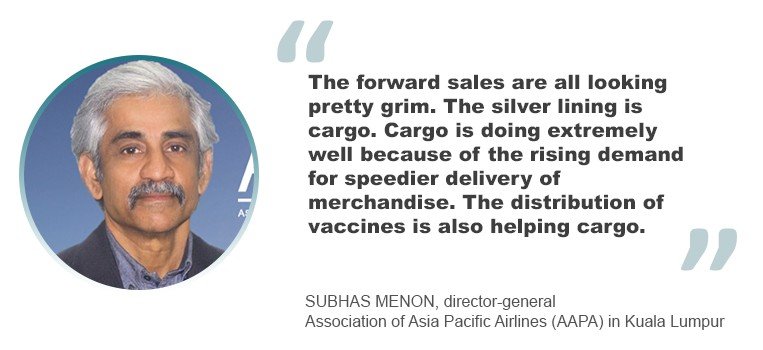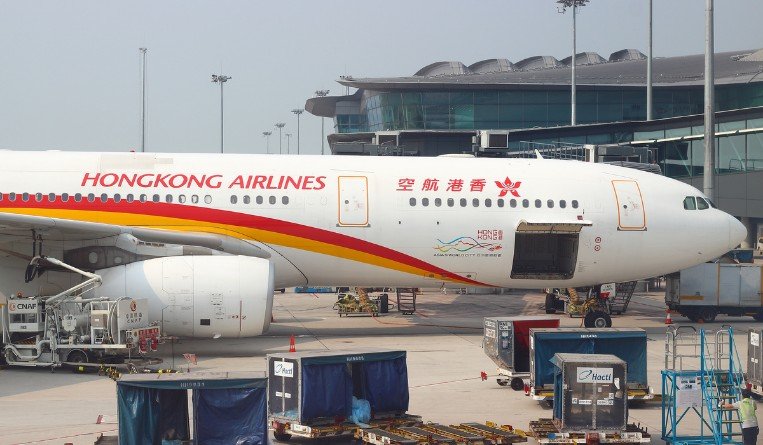The recovery of the airline industry in the Asia Pacific region may take a little longer, according to aviation officials citing persisting border restrictions and the lack of standardized border-crossing protocols continuing to drag prospects of an upturn any time soon.
But as passenger business for airlines is expected to remain weak, cargo operations will continue to be a bright spot for the industry — especially with the demand surge from the roll-out of vaccine distribution worldwide.
Subhas Menon, director-general of the Kuala Lumpur-based Association of Asia Pacific Airlines (AAPA), told a recent CAPA Live event that traffic was showing “some signs of life” towards the end of 2020, but that restrictions had been reintroduced as coronavirus cases continued to spike.
“There was a lot of optimism because of the discovery of vaccines and the start of the rollout of vaccines. Everything came to an abrupt end at the end of 2020, and 2021 didn’t start well,” Menon said during the panel discussion on the Asia aviation outlook this year.
“In January, we saw the numbers race backwards, even lower than what it was in 2020,” he added.

With the slow start to 2021, the AAPA chief noted that the outlook for aviation in the region remains bleak.
“The forward sales are all looking pretty grim. The silver lining is cargo. Cargo is doing extremely well because of the rising demand for speedier delivery of merchandise. The distribution of vaccines is also helping cargo,” he added.
Menon cited the contribution of cargo in cutting the losses of some Asian carriers like Singapore Airlines. Korean Air also boosted its operating profit last year despite the big aviation hit of the coronavirus pandemic due to strong cargo sales.
“This is a good sign, but of course when passenger numbers are down, capacity is down, there’s also very little capacity for cargo,” the APAA chief said.
Restrained capacity as bellyhold space remains limited has prevented carriers from taking full advantage of the cargo demand present in the market.
Menon noted that moving forward, though, good revenue numbers won’t be able to lift carriers’ other losses.
“It is not very sustainable just to rely on cargo. Governments are actually spooked by the surge in virus cases in Europe and America as well as the mutation of the virus. Understandably they have become more stringent with their border controls,” he said.
Standardized protocol needed to reopen
That said, the AAPA director-general added that although “governments are doing whatever they can,” most of it is currently focused on “wage relief, as well as subsidies” and some also a cash injection.
When asked by Peter Harbison, the Sydney-based Centre for Aviation (CAPA) chairman emeritus, whether governments in Asia are doing enough – like the “more active involvement” seen from governments both in Europe and in the US – Menon said there is much more to be done, particularly in coming up with a standardized set of health protocols to facilitate reopening of borders sooner.
“I think they can do much more and they have the capacity to do much more. I think they will because it is such an important part of the economic makeup of Asia, tourism as well as air transport. I mean, Asia is not contiguous. They need this tremendously, so they will support it,” Menon said referring to the necessity of air transport in archipelagic countries in Asia like Indonesia and the Philippines. “Without air transport, the whole country will fall apart. They cannot be connected.”
“What we need on the government side is for them to come together to standardize the documentation for certification, as well as come to some agreement as to how they’re going to allow the border access controls to be part of this travel solution,” he added.
“It will require a multilateral agreement between governments among governments to go ahead with this,” he added.
“The timeframe for borders to reopen is really tied to the vaccine ability, immunization. Once that is done, I think borders will reopen.”
Challenge cited for Indonesia, Philippines
Mario Hardy, CEO of the Pacific Asia Travel Association in Bangkok, noted that in terms of reopening, archipelago countries such as Indonesia and the Philippines could bounce back slower than the rest of the more-connected countries in the region due to decreased air transportation between islands.
“I would actually tend to believe at the moment for 2021, looking at the more pessimistic version, but with the hope and anticipation that 2022 and 2023, we would start to see a rebound again,” he said.
AAPA’s Menon, noted, however, that the presence of vaccines is already a “cause for optimism” that the aviation industry is closer to emerging from the big hit of the coronavirus pandemic.
“My take is that at least we have a solution. Vaccines are a solution, so there is some cause for optimism. Of course, the implementation and the mechanics are bogged down in detail because of the government’s preoccupation with trying to contain the virus,” he said.
“Once they get into the groove of things and they realize what is happening to their economy and also those who are dependent on the aviation sector for survival and growth, I think they will get their act together.”



